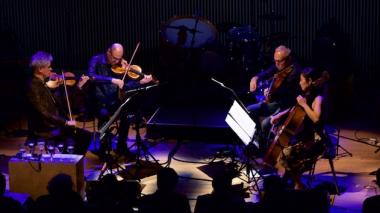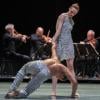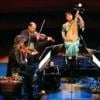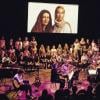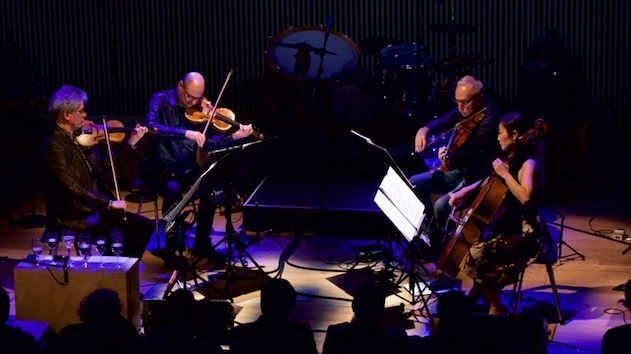
What can artists do, in their capacity as artists, to register political protest? This is an especially vexing question for instrumentalists who traffic in abstract music. How do they communicate their concerns in their art?
Kronos Quartet has found an answer in its new program, “Music for Change: The Banned Countries,” which it brought to Bing Concert Hall for Stanford Live on Saturday. This program of works from a variety of Northeast African and West Asian nations is not just a protest against the executive orders revoking visas and limiting entry into the U.S. for nationals of some of these countries. It’s also a cultural exchange program, giving composers from these places an audience, inviting American listeners to hear their music through Kronos’s mediating and modifying offices. The quartet’s long experience with culturally diverse and politically charged music made this project a natural fit.
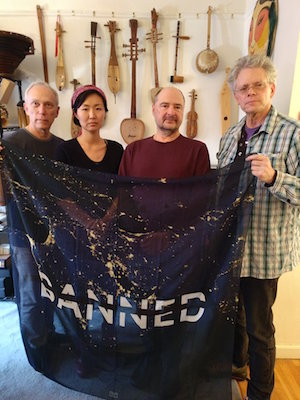
The original travel ban was issued in January 2017. It’s taken until now to put this program together, partly allowing time to commission new works — three of the items were receiving first performances — and partly from sheer logistics, particularly when some of the composers — such as Iran’s Aftab Darvishi, who sent a heartfelt recorded message to Thursday’s panel discussing the cultural effects of the travel ban — cannot visit the U.S. to participate in rehearsals or hear their music performed.
The program was hardly a concert, the kind made of distinct pieces separated by pauses, bows, and applause. It was a free-flowing, stream-of-consciousness experience, running continuously for some 75 minutes. No words were spoken from stage. The program began with cellist Sunny Yang playing alone in darkness. Gradually a spotlight shone on her, and the other Kronos members joined her still in darkness, with broader light only emerging in the second piece.
Recorded interstitial music of bass lines and sound collages — Middle Eastern singing, traffic, sirens, and whatnot — linked the compositions, often spilling over into the live music, some of which had electronic supplements of its own. Sometimes the interstitial music would stop and then restart. Combine all of this with a program of unfamiliar pieces, which often stopped in the middle or abruptly changed styles themselves, and an auditorium too dark to read the program in, and it wasn’t always clear when one work ended and the next began.
However, I counted 12 pieces, and that’s the number listed in the program, so I can say with fair confidence that Darvishi’s Winds from South was the attractive piece with intertwining lines of a slightly Shostakovich-like flavor, calm rather than quiet. The only other placid music came in the sad, slow harmonies of Stephen Prutsman’s arrangement of the Lebanese Christian hymn Wa Habibi. The harmonically pregnant chugging rhythm in Escalay (The water wheel) by Hamza El Din from Sudan — it kept sounding like it was about to shift into something else — had a similar soothing effect.
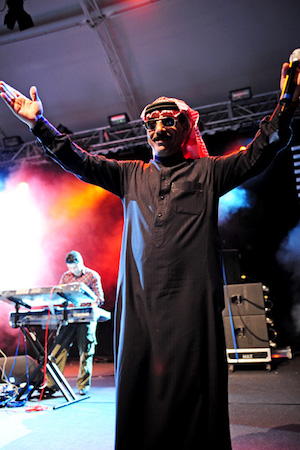
Other pieces were fast and livelier. The biggest audience reaction — a burst of applause afterward actually interrupted the flow of the program — was for La Sidounak Sayyada (I’ll prevent the hunters from hunting you) by Omar Souleyman from Syria. Based on folk dance party music, it ran on fast, complex, folk-pop rhythms, some of them electronic, keeping the energy up. The song Dooyou by the Dur-Dur Band from Somalia was also based on pop rhythms, this time with the sound of a drum kit, while Tashweesh (Anxiety) by the Ramallah Underground from Palestine was more industrial pop.
Some of the music had unusual sonorities. The harmonies in Milad Yousufi’s arrangement of an Afghan folk song, Bia Ke Berem Ba Mazar (Come, let’s go to Mazar) sounded slightly nasal, like an accordion. A Sephardic Jewish prayer arranged by Jacob Garchik from the singing of a rabbi from Turkey, Izak Algazi, was intensely pentatonic. Dmitri Yanov-Yanovsky, from Uzbekistan, instructs the instruments in a movement from his Chang-Music IV to spend much of their time tapping the bodies of their instruments, and much of the rest playing pizzicato or col legno. Pareeshān (Abstracted), by the Iranian Sahba Aminikia, featured electronic echo, especially reverberant on sudden high notes.
Despite the variety of sounds between pieces and sometimes within pieces — Aminikia’s Pareeshān and Mugam Sayagi (In the style of Mugam) by the Azeri composer Franghiz Ali-Zadeh contained the strongest internal differences — there was a broader similarity to the entire program. Many of the works were vocal in their original form, and virtually all of them were dominated by wailing vocalise-style work from David Harrington’s first violin. Harrington has been channeling singers in this way in other pieces arranged for Kronos, and by now he has it down to an art. Differing expressive vocal styles, varying tones of voice, subtly bent pitches: He does it all. Melodic and rhythmic styles varied among these works, and some were double-stopped, but the principle was constant.
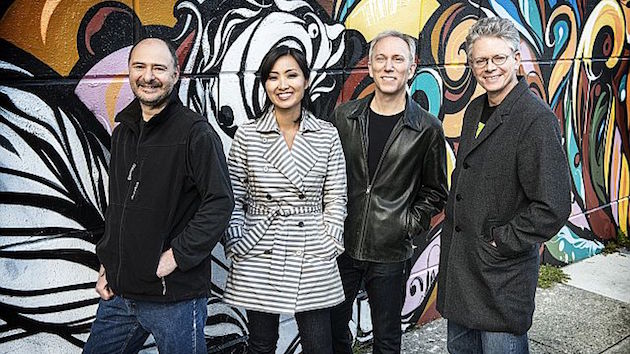
Sometimes second violinist John Sherba or violist Hank Dutt would join Harrington briefly for a double vocal line or take over the vocal part for a while. Otherwise they played accompaniment of varying kinds: oscillating rhythms, pizzicato, intertwining lines, col legno, tapping on the body of the instrument, even — in the Ali-Zadeh piece and Zaghlala (Blurred vision) by Islam Chipsy from Egypt — replacing their strings with small percussion instruments like gong or triangle.
Yang on cello joined Sherba and Dutt — and Harrington, when it was his turn to play accompaniment — in all these practices. But her solos were entirely different from theirs, purely instrumental in style: long-held notes, half-swallowed cadences, grinding pulls of the bow, and pizzicato flourishes in the manner of jazz double-bass players.
If the patterns of similarity discernable here owe anything to cultural resemblances in the originals, they’re more due to the native style of the Kronos Quartet transmuting everything it plays. Its efforts succeeded in reaching the audience: the long program was a continually transportive experience. Can the musicians of Kronos heal the rifts in the world or turn the hearts of xenophobes with concerts such as this? Probably not, but how rewarding it is to listen to them try.

